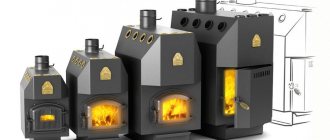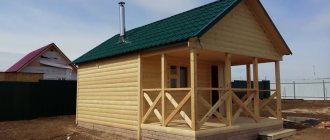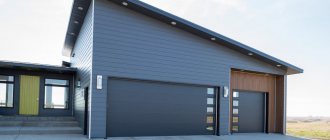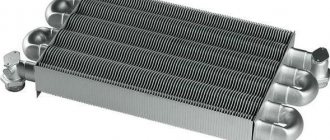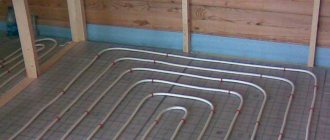Advantages of gas boilers
Gas boilers have become widespread because they are practical and easy to use, and have reasonable prices for equipment and for the process of further operation.
Autonomy
Autonomous or independent devices are those that do not require constant connection to general communications .
If you drill a well and make a large reservoir, then in terms of water supply the house will be considered autonomous, since it does not depend on a centralized water supply. A similar system operates for a gas boiler.
If there is no gas pipeline nearby, and to heat with wood and coal , then installing a boiler running on natural or liquefied gas will significantly simplify and reduce the cost of heating the house.
Reference. Autonomy is achieved due to the fact that the gas is in cylinders . Therefore, it can be transported to any place. It is enough to allocate a small space for cylinders and connect them to the system.
The downside of cylinders is their rapid emptying . In this case, you purchase either a mobile gas holder or a stationary one , which holds a much larger amount of gas and is able to heat the house for longer.
High efficiency
The average efficiency of a properly operating gas boiler is more than 90% . It all depends on the type of fuel, type of device, ambient temperature and other factors.
Some units have significantly higher efficiency - about 95%, while others have a slightly lower efficiency . 90% is taken as the average indicator .
This value is in any case higher than that of solid fuel . The combustion of gas leaves a minimal amount of “waste” , but it is transferred to the atmosphere as carbon.
And if we add to this factor the low price of fuel , then a gas boiler becomes a cost-effective heating device.
Long working life
The service life of the boiler depends on several factors :
It is logical to assume that cheap unit is unlikely to last long enough, because during its production money is saved on equipment, on safety systems, and on the quality of the material. The average service life of an inexpensive boiler is about 10-15 years , while high-quality device can last 20-25 years .
- From correct operation .
If there are power outages in an apartment or house, it is better to purchase an uninterruptible power supply for an on-line system .
It rectifies the incoming current and prevents voltage surges , instantly switching to its own resources. This precaution will allow you to save the most expensive part of the boiler - its electronics, the price of which can be from one third to half the cost of the boiler itself.
- From the quality of the fuel .
At first glance, it may seem that the gas is not diluted. In fact, like diesel and gasoline, gas can also be far from being of the highest quality. Therefore, you should buy it only from trusted suppliers .
All these measures will maximize the service life of the boiler.
Compactness
A gas boiler does not require large premises for its location. The size of the device can be slightly larger than a washing machine . This makes it possible to attach the unit to almost any place: in the bathroom, toilet, corridor, pantry, boiler room (if available). Even a small apartment can accommodate a gas boiler, which will be an additional source of heating.
The lack of storage space can be called a positive thing only if the living space is connected to the main gas pipeline system .
For full operation, such a boiler only requires a connection to a gas pipe .
On the other hand, autonomous gas devices require organizing space for cylinders or a gas holder .
If this causes inconvenience to apartment owners, then in a private house you can find a place for the device or create one. In this regard, it is much more convenient to have stationary gas tank.
It is buried in the ground and formally does not require any space in the house or on the street, and due to its large volume it is filled once a year . With moderate gas consumption and an insulated house, the gas holder will last for a long time.
Easy to use
It will not be difficult for an adult to understand the main functions of the boiler, find the on and off buttons , as well as gas supply
valve The system is assembled in such a way that it is easy for its owners to perform the necessary manipulations.
Gas roof boiler room
The device has the following positive aspects:
- High efficiency. Thanks to the use of liquefied gas, which releases energy when heated, fuel consumption is reduced.
- There are almost no external communications. This reduces costs. Heat loss is also reduced.
- In low buildings (up to 26 m) there are no additional installation requirements, which reduces the cost of the project.
- Automation, which reduces operating costs.
- The device is not turned off for annual inspection, which allows daily use of hot water.
The device has several limitations. To accommodate the boiler room, the roof is strengthened by installing a concrete pad. Preliminarily calculate the load that the building can withstand.
Special equipment is brought in for installation, the operation of which creates inconvenience for residents. The cost is also unpleasant: the costs go towards creating the project, laying the gas carrier, and the automation responsible for control. Additionally, protective measures and a fire extinguishing system are installed.
Disadvantages of boilers
Gas boilers have few , but they are quite significant .
Obtaining permission for installation in a house or apartment
To do this, several aspects :
- the room where the gas boiler will be located must be fenced off from other rooms by walls and a door;
- it is necessary to install a gas meter - this rule is not mandatory in the documentation, but without it a permit will not be issued.
Attention! Gas belongs to explosive substances . Therefore, it is quite logical that the boiler, as a potentially dangerous object, can be installed only after obtaining the appropriate permit.
An application for installation is submitted to the regulatory authority , as a rule, it is either Gorgaz (in the city) or Oblgaz (in the region). To obtain permission, you must:
- Develop specifications for connection to the gas main - this takes from two weeks to a month , all the main points of connection are taken into account. The issuance of specifications actually gives permission to develop the project.
Photo 1. A similar diagram of connecting a gas boiler to the heating system will be needed to obtain permission for installation.
- The gasification project should be entrusted to specialists from regulatory authorities. According to the law, any licensed design office has the right to develop a project, but it is better to contact a government specialist. Production time is from two weeks to one month .
- Coordinate documents with Gorgaz and obtain permission to install a gas boiler. To do this, it is necessary to provide specifications, a gas supply project and a building plan, permission from Rostechnadzor and other technical documentation for the boiler being installed.
Reference. All legal formalities may take from three months to six months .
Sensitivity to failure and risk of leakage
Like the electrical network, the gas main supply cannot boast of stable operation. You need to be prepared for this and, if possible, have the contacts of a technician on hand who can fix the problem in a short time. Autonomous boilers are practically free of this drawback , since gas is supplied stably from the storage facility. You just need to monitor its quantity and replenish supplies on time.
Gas heating
As a rule, apartment owners face a choice between two types of alternative heat sources:
- Designs based on a gas boiler.
- Electric heating systems.
Gas heating has a number of advantages:
- Modern boilers are equipped with an increased security system and operate autonomously. maintaining the level of heat that residents need.
- Such boilers have small dimensions. therefore, they can be installed in even small rooms.
- It is easy to install, so with proper attention and some tools and skills, even a beginner can do it.
- Autonomous gas heating in the apartment is equipped with a chimney system and does not have to be installed separately.
- Gas boilers operate absolutely silently. so that they will not cause complaints from neighbors.
- An affordable price and complete set of all components and parts make gas heating the most common choice among consumers.
When installing new heating, the old system must be dismantled. It is easier and cheaper to install new radiators than to try to fit old ones to it. Although modern gas boilers have the highest degree of protection, gas leakage is still possible.
Operating principle of a condensing gas heat generator
Before we talk about the nuances of condensation technology, we note that an energy-efficient, and therefore comfortable and economical, country house is a balanced structure. This means that, in addition to a closed thermal insulation circuit, all elements of the cottage, including the engineering system, must be optimally matched to each other. Therefore, it is so important to choose a boiler that combines well with a low-temperature underfloor heating system, and will also reduce energy costs in the long term.
In Russia, unlike European countries, condensing gas boilers are less common. In addition to environmental friendliness and greater comfort, this type of equipment allows you to reduce heating costs, because such boilers operate 15-20% more economically than conventional ones.
If you look at the technical characteristics of condensing gas boilers, you can pay attention to the efficiency of the equipment - 108-110%. This contradicts the law of conservation of energy. While, indicating the efficiency of a conventional convection boiler, manufacturers write that it is 92-95%. Questions arise: where do these numbers come from, and why does a condensing gas boiler work more efficiently than a traditional one?
The fact is that this result is obtained thanks to the thermotechnical calculation method used for conventional gas boilers , which does not take into account one important point: evaporation/condensation. As is known, during the combustion of fuel, for example, main gas (methane CH4), thermal energy is released, and carbon dioxide (CO2), water (H2O) in the form of steam and a number of other chemical elements are formed.
And water vapor in a convection (ordinary) heat generator actually “flies into the chimney,” taking with it part of the heat (generated energy) into the atmosphere. Moreover, the amount of this “lost” energy can reach up to 11%.
To increase the efficiency of the boiler, it is necessary to use this heat before it is lost and transfer its energy through a special heat exchanger to the coolant. To do this, you need to cool the flue gases to the so-called temperature. “dew point” (about 55 °C), at which water vapor condenses and useful heat is released. Those. — use the energy of phase transition to maximize the use of the calorific value of the fuel.
Let's return to the calculation method. Fuel has a lower and higher calorific value.
- The gross calorific value of a fuel is the amount of heat released during its combustion, taking into account the energy of water vapor contained in the flue gases.
- The net calorific value of a fuel is the amount of heat released without taking into account the energy hidden in water vapor.
The boiler efficiency is expressed in the amount of thermal energy obtained from fuel combustion and transferred to the coolant. Moreover, when indicating the efficiency of a heat generator, manufacturers can by default calculate it using the method using the lower calorific value of the fuel. It turns out that the real efficiency of a convection heat generator is actually about 82-85% , and a condensing heat generator (remember the 11% additional heat of combustion that it can “take” from water vapor) is 93-97% .
Condensing boilers provide maximum efficiency if the coolant return temperature is less than 55 °C, and these are low-temperature heating systems “warm floors”, “warm walls” or systems with an increased number of radiator sections. In conventional high temperature systems the boiler will operate in condensing mode. Only in severe frosts will we have to maintain a high temperature of the coolant; the rest of the time, with weather-dependent regulation, the temperature of the coolant will be lower, and due to this we will save 5-7% per year.
The maximum possible (theoretical) energy savings when using condensation heat is:
- when burning natural gas – 11%;
- when burning liquefied gas (propane-butane) – 9%;
- when burning diesel fuel (diesel fuel) – 6%.
Disadvantages of wall-mounted gas equipment
Wall-mounted boilers have a number of disadvantages, the main one of which is the low power of the equipment. Manufacturers produce a wide range of models, but the most powerful of them are designed to heat a room up to 350 sq.m. It is logical to assume that in a building with a larger square footage there is a small room for installing more powerful floor-standing equipment.
Other disadvantages :
- high requirements for constant pressure in the gas main;
- the diameter of the heating system pipes must be large;
- Sharp bends of heating system pipes are not allowed;
- It is advisable to make do with a minimum number of turns when laying pipes.
Double-circuit models are quite demanding in terms of maintenance, which is explained by the complexity of the design of boilers of this type.
Heating control using a GSM module . The property owner can remotely control the temperature of the coolant, receive timely information about power outages and other emergency situations. One of the main objectives of remote control is to minimize energy costs. Using a regular smartphone, you can set a comfortable temperature before your household returns to the cottage or apartment, and in their absence, keep the burner wick at a minimum. During the working day, the house is empty, which means half the day can be spent heating the room with fuel 1.5-2 times less than the usual norm.
Advantages of using a condensing gas boiler
So, we have dealt with the theoretical part. Now we’ll tell you how the design features of a condensing boiler affect its operating efficiency and durability. At first glance, it seems that it is possible to use the additional energy of water vapor hidden in the flue gases in a conventional boiler, specially “driving” it into a low-temperature operating mode. For example, by connecting the boiler (this is incorrect) directly to the underfloor heating system or by significantly lowering the temperature of the coolant circulating in the radiator heating system. But, we already wrote above that during the combustion of main gas a whole “bouquet” of chemical elements is formed. Water vapor contains: carbon dioxide and carbon monoxide, nitrogen oxides, and sulfur impurities. During condensation and the transition of steam from a gaseous to a liquid state, these impurities end up in water (condensate) and the output is a weak acidic solution.
The heat exchanger of a conventional boiler will not withstand prolonged operation in an aggressive chemical environment; over time it will rust and fail. The condensing boiler heat exchanger is made of materials that are corrosion resistant and resistant to acidic environments. The most resistant material is stainless steel.
In addition, increased requirements are placed on other structural elements of the condensing heat generator, because it is necessary to cool the flue gases to the required temperature. For this purpose, the boiler is equipped with a forced-air burner with a high degree of modulation. This burner operates over a wide power range, which allows you to optimally regulate water heating. Condensing boilers are also equipped with automatic equipment that ensures precise maintenance of the combustion mode, temperature of the exhaust gases and water in the return line. Why are circulation pumps installed that smoothly change the pressure force of the coolant flow, and not as simple 2- and 3-speed pumps? With a conventional pump, the coolant flows through the boiler at a constant speed. This leads to an increase in the temperature in the “return”, an increase in the temperature of the flue gases above the dew point, and, consequently, a decrease in the efficiency of the equipment. It is also possible for the heating system (warm floor) to overheat and reduce thermal comfort.
What's wrong with centralized heating systems?
Gas and electricity have advantages that are hard to ignore.
The advantages of heating systems using gas or electricity are obvious, but in some cases it is necessary to look for alternative sources of energy supply and study the technical conditions of other types of home heating. As an alternative to gas and electricity, there are the following types of heating systems for a private home:
- heating with liquid fuel;
- heating system using solid fuels;
- combined heating systems for home;
- autonomous heating system using a heat pump;
- solar collectors.
The listed types of heating are effective in their own way for organizing heating of residential premises. Each option has both pros and cons. For most residents of city apartments, there are no effective heating systems for an apartment building other than a gas and electric boiler. Connecting other sources of energy supply in a private home is quite acceptable and feasible.
By doing a comparative analysis of the effectiveness of currently existing autonomous heating systems, taking into account all the technical nuances and applicability in an apartment or private house, you can choose the best option specifically for your specific conditions.
The main emphasis is on the use of certain fuel sources in the long term. Cheap fuel rarely has good calorific value. The autonomy of the system is also an important factor when choosing the type of fuel. Combining various types of fuel and heating systems into a single complex can solve the problem at a certain stage. Only an accurate calculation will allow you to determine the efficiency of heating in your home.
The experience of many decades of operating traditional centralized heating systems allows us to draw very accurate conclusions. Firstly, “ancient” radiators (batteries are well known to all of us) heat rooms by convection - they heat the air directly in contact with them, which then naturally moves around the room. As a result, the heated and dried air gradually accumulates mostly under the ceiling.
In the lower part of the room, exactly where heat is needed, it is much colder than under the ceiling. Moreover, favorable conditions are created for the formation of condensation. And no less unpleasant is the rise of dust and germs from the floor. This whole set doesn’t look the best, considering how advanced heating systems have become in Western countries.
Here we come to the main point. Serious sociological studies have shown that the majority of citizens of the Russian Federation, even if the centralized system operates normally, would prefer individual heating in the apartment if they had such an opportunity.
Every developer dreams of having an economical heating system for a private home. You can save on 3 key things:
- Financial. Make an inexpensive heating option
- Savings in terms of heating system
- Savings in terms of modern technology
Before installing heating you need to decide:
- For what purposes will the house be used? Will you live there permanently or visit periodically? The payback period of the heating system depends on this. It may be useful to install an economical heating option.
- What is key for you: saving on heating now or investing in the heating of a private home for the future.
- Decide which fuel will perform the key function
Now it remains to find out which heating system for a private home is the most economical. In this category, water heated floors win by a decent margin. And that's why:
- Heated floors are at least 30% more economical than radiators (subject to special conditions for temperature control and boiler installation for low-temperature systems);
- Warm floors heat from bottom to top, while radiators heat the ceiling first;
- Heated floors operate at low temperatures. The high limit is 45 degrees.
- Warm floors can be heated with anything.
That's exactly what they say all over the Internet. In fact, all modern systems are approximately the same in terms of efficiency. It doesn't matter what you install, it's important how accurately you adjust it all. The more accurately the heating system is adjusted, the more economically it operates.
In practice, 5 cm on the first floor is quite enough. Unless, of course, you live in a region with extreme cold.
Read more: Design and principle of operation of a water supply pumping station
Gas is the most economical energy carrier for heating a private home. Gas heating does not require constant human intervention. What can you say about coal heating?
Gas is not available everywhere. Therefore, you often have to choose either coal or electricity. Plus electric heating - turn it on once and forget it. Coal must be constantly added to the boiler.
Features of operation of a condensing gas boiler
Frequently asked questions from consumers: what to do with the condensate obtained during the operation of the boiler, how harmful it is, and how to dispose of it.
The amount of condensate can be calculated as follows: per 1 kW*h there are 0.14 kg. Consequently, a condensing gas boiler with a power of 24 kW when operating at 12 kW of power (since most of the heating period the boiler operates with modulation, and the average load on it, depending on conditions, can be below 25%) on a fairly cold day produces 40 liters of condensate at low temperature.
Condensate can be drained into the central sewer, provided that it is diluted in a ratio of 10 or better 25 to 1. If the house is equipped with a septic tank or local treatment plant, neutralization of the condensate is required.
The neutralizer is a container filled with marble chips. Filler weight – from 5 to 40 kg. It must be changed manually on average once every 1-2 months. The condensate, usually passing through the neutralizer, flows by gravity into the sewer system.
Advantages and disadvantages of gas boilers
Many owners of houses and even apartments, when choosing a heating product, most often choose gas boilers . A UPS is required for a gas boiler. In most countries, this is the most optimal heating option, because gas is one of the cheapest types of fuel there.
And for country houses and cottages it is very convenient to have an autonomous automatic heating system. But, like other heating products, gas boilers have their own pros and cons, which should definitely be taken into account when choosing this unit. In this article we will look at the advantages and disadvantages of gas boilers.
It would be logical to start with the advantages of this means of heating, because it is difficult to argue with them, and therefore many people choose gas boilers. So, the advantages of gas cats are as follows:
- the efficiency of a gas boiler is very high, and given the low cost of gas, this device produces much more energy than it absorbs;
- thanks to this, a gas boiler is able to heat fairly large rooms well, something that other heating products cannot always “boast” of;
- you don’t have to rack your brains over the place where the fuel will be stored, and the operation and repair of gas boilers is also relatively simple;
- The undoubted advantage of gas boilers is that they can last for many years, so a gas boiler made of cast iron can last you half a century, and a boiler made of steel – at least 15 years.
Undoubtedly, the advantages here are enormous, but the disadvantages of such heating are also important. Let's now move on to the disadvantages of gas boilers:
- to install and operate a gas boiler, you need to obtain a certain document from the government service that will allow you to do this;
- if any malfunctions occur in the gas pipe, then the gas boiler may react sensitively to this, for example, it may become smoky;
- if you have a large house (more than a hundred square meters), then it is not advisable to use a gas boiler; economically it is unlikely to be very profitable;
- you need to carefully monitor that, God forbid, a gas leak does not occur, because safety is most important.
Advantages and disadvantages
Advantages
Let's take a closer look at the second option and determine its positive and negative sides. First, let's figure out what an autonomous heating point is. This is a separate room where boiler equipment is located, the power of which is sufficient to provide heat and hot water to the entire apartment building. This is a kind of mini-boiler room with a full set of necessary instruments, fixtures and systems. Modern technologies for providing heat to residential buildings have begun to be used in autonomous systems. The latter worked for one or several houses, which was doubly profitable. Why?
- Firstly, the distance from the heat generator to the heating devices in each apartment has been significantly reduced. This means that heat loss has decreased due to the transportation of coolant.
- Secondly, the time for supplying heat to the consumer has been reduced, which is again due to a decrease in distance.
- Thirdly, the costs of maintaining heating networks, their repair and installation have changed less.
- Fourth, economic indicators resulting from previous benefits have declined. This means that the cost of the supplied coolant has changed to a minimum.
Autonomous system diagram
There is one more advantage of the system. When a house is being built, the developer is required to obtain a large number of permits that will allow him to crash into the central highway. Bureaucratic delays sometimes take months. And the installation of a metering device will cause a lot of disputes between developers and the receiving party, that is, the operating company. So for builders, option c, even for the largest house, is ideal.
And the last advantage is that the boiler room for the microdistrict occupies a place where not only buildings and water tanks will be erected, but also an electrical substation, access roads, warehouses, office premises, administrative buildings, etc. That is, a fairly impressive area will have to be allocated for it. And if there is no longer a need for a boiler room, the district administration can use this area for its own needs. For example, build another residential building, school, clinic, etc.
Flaws
Gas boilers
There are disadvantages in any system, but they are usually fewer:
- An autonomous boiler room must be located in a separate building, so it is necessary to allocate an area near the house for it. Sometimes such a building takes the form of an extension.
- Mini-boiler houses pollute the environment to a certain extent. Therefore, it is impossible to do without modern cleaning devices. And being located inside microdistricts obliges us to create conditions for environmentally friendly operating indicators. They exist and are stipulated by the norms and rules of SNiP. Hence the increase in the cost of the equipment itself.
- The autonomous heating system is not yet as popular as the centralized one, so the production of equipment and related components has not yet been put into production. Hence the high cost of such systems. This means that not all developers can afford them.
Heating regulator
However, experts say that engineering developments today can eliminate some of the shortcomings. For example, if an autonomous boiler room is used to heat only one apartment building, its equipment can be placed in the attic - the dimensions of the devices allow this to be done. In addition, the attic immediately becomes heated, which is undoubtedly a plus. In addition, the area between the houses is freed up. The only requirement for such options is the presence of a flat roof, which is not a problem. If you plan to install just such a heating system, you can add a flat roof to the project. Experts have already carried out preliminary calculations, which have shown that even if the cost of equipment and installation costs are high, it will all pay off in a few seasons.
What is a double-circuit gas boiler
- A double-circuit gas boiler is an installation that is a device capable of producing energy in the form of heat created by burning gas. This energy heats the coolant, which passes through the core of the boiler and goes further, obeying natural or forced circulation in the heating circuit, and also heats the water in the boiler and used for household needs.
- There are two types of such boilers:
- double-circuit wall-mounted gas boiler;
- gas boiler, double-circuit, floor-standing.
Such a heating structure consists of the following elements:
- gas stove;
- igniter first and main;
- heat exchanger;
- heating circuit;
- DHW circuit;
- a pipe used as a chimney through which combustion products are ventilated;
- expansion tank;
- pump that creates circulation;
- automatic device that controls the boiler;
- safety monitoring device.
How to choose the right boiler
These days you can buy a gas boiler for heating a private home at any construction supermarket. When choosing a German or Russian unit, you must, first of all, pay attention to its thermal power. Competent sales consultants will help you choose a wall-mounted or floor-mounted unit; they will need to tell you the area of the premises expected to be heated.
How to calculate power
Accurate calculation of thermal systems involves taking into account dozens of parameters and is the prerogative of professionals. In order to select a boiler yourself, you can use a simple formula that is suitable for standard private houses with ceiling heights of up to 3 meters. For this, it is assumed that to heat 10 m2, 1 kW of declared power is required.
For a more accurate calculation, you can use online calculators, which are special utilities. By entering data on the number of windows, wall thickness and other parameters into the program, you can obtain the required power of the heating equipment yourself.
There is also a calculation option that takes into account the regional climate coefficient.
How to legally move a gas boiler and what are the risks of illegal installation of the device? The answer is on our website via the link.
Specifications
Due to their external aesthetic qualities, double-circuit gas boilers fit perfectly into any interior design.
Technical data suggests that such a device can simultaneously function in two areas, such as:
- heating water;
- space heating.
If the user purchases a wall-mounted gas boiler, then he significantly saves usable space and there is no need to build a separate room for the selected model. If it is necessary to place a floor-standing boiler, then it is necessary to build, in accordance with all the rules, a separate building in which the boiler room will be located.
The most important advantage of double-circuit gas boilers is that they have the technical ability to connect a boiler, which single-circuit units do not have. To heat the water there is a water heater that works like a flow-through one.
The power of such devices ranges around 30 kW.
The heated area should be no more than 180-280 square meters. m.
According to manufacturers' recommendations, it is worth installing such a system as close as possible to the points where water will flow, so that the heating process begins immediately. It is also necessary to place rooms one after another where hot water will be distributed.
It is extremely inefficient to install points with hot water distributors in different directions, because then it will take much more fuel to warm up and supply water at the required temperature.
Is it legal to install an individual heating system?
There are many disputes and lawsuits on the legality of installing autonomous heat supply equipment in a separate apartment. It all started with the fact that in 2010 the Russian government banned the disconnection from general heating supply and the transition to individual heating, forcing many people to give up. But in 2012, a new law was adopted that concerns the procedure for connecting heating systems.
It notes a list of heat sources that are prohibited for use in apartments. This list does not include modern certified heating boilers. Consequently, the law does not prohibit the installation of your own heating, and all restrictions relate only to the technical features of heating systems.
This does not mean that the owner of the premises can freely install individual heating. Before doing this, it is important to obtain permission from local authorities. If the administration does not issue it to you, go to court, since such a refusal is illegal.
How to get permission?
For permission to install autonomous heating, you must contact the district administration, which is responsible for the use of the housing stock. Within 1.5 months, officials give an official response. From the administration you can obtain a list of documents that must be provided to obtain permission.
List of documents
Since the installation of the heating system itself relates to the refurbishment of a residential premises, the document will consist of the following documents:
- a statement written in accordance with a special form;
- documents of apartment ownership: certificate of state registration, deed of transfer of ownership, gift agreement, document confirming the right of inheritance;
- certified copies for each owner and a statement signed by all owners.
- a copy of the technical passport of the premises;
- consent of family members of the tenant and residents of the multi-storey building, drawn up in the form of minutes of the meeting of apartment owners;
- conclusion of the body responsible for the protection of architectural monuments, historical or cultural heritage on the possibility of organizing redevelopment.
We recommend: How to make autonomous heating for a garage?
The hardest part is preparing and providing technical documentation. It is customary to include:
- redevelopment plan for the installation of gas equipment, consisting of gasification of the premises and changes to the central heating system;
- a duplicate of the passport for the electric boiler, technical conditions, agreement, which confirms the permission of the maximum power exceeding the capabilities of the equipment;
- Specifications for disconnecting the wiring in the apartment from the public heating system;
- Specifications for ventilation;
- Specifications for supplying gas networks.
What to do when obtaining permission?
If you did everything correctly and received a positive verdict, you need to buy equipment and enter into an agreement with a company that installs autonomous heating. After completing the re-equipment and carrying out all the work on installing the new system, it is necessary to officially formalize the installation of individual heating. If your budget allows, you can save yourself from bureaucracy and entrust this task to a design service for a fee. Now you know the difference between autonomous heating and individual heating.
YouTube responded with an error: The request cannot be completed because you have exceeded your quota.
- Related Posts
- How to make autonomous heating in a private house?
- Is it possible to install autonomous heating in an apartment building?
- Types of autonomous heating of industrial premises
- Advantages of autonomous gas heating
- How to make autonomous heating for a garage?
- How much does autonomous heating cost?
Types of double-circuit gas boilers
The type of gas boilers is divided according to several criteria:
- According to the principles of using combustion products:
- convection;
- condensation
- According to the design provided in the heat exchanger:
- separate;
- bithermic.
- By type of combustion chamber:
- closed;
- open.
The first type has a number of advantages and disadvantages, namely the fact that thermal energy is not used to its full potential is attributed to the disadvantages. The advantages include relative ease of use and budget price.
The advantages of the second type include a separate design, since if any of the parts fails, it can be replaced - this will be very problematic with a monolithic block. The disadvantages include the following: when a person takes a shower, the water must be turned on a little in advance, because it heats up to such an extent that you can get a thermal burn.
For combustion chambers, a closed type chamber is preferable, as it is safer.
Principle of operation
Such boilers are the most interesting and budget option for heating a home, since gas is one of the cheapest types of fuel. Even if we compare the costs incurred by a house in which there are many apartments, then in the case when it is connected to the gas main, the economic cost item will be much lower than where everything is based on power from electrical networks.
By moving to a permanent place of residence outside the city and connecting gas to their heating system, people save significantly, since they pay, instead of mythical utilities, the real price for the availability of fuel. At the same time, the owners can regulate the duration of fuel use themselves, that is, turn the device on and off as needed. Because the operating principle of such an installation as a gas double-circuit boiler for heating a private house is as follows:
- A double-circuit gas installation, if it is installed in a wall-mounted version, then it is not very important where it will be located. But if a floor-standing option is used, then a separate boiler room will be needed. But there are two important points. Firstly, it must be possible to connect the boiler to the main gas, and secondly, it is necessary to install a chimney system through which combustion products, such as smoke and carbon monoxide, will freely escape outside.
- Also, a thermal circuit must be connected to the boiler, through which the coolant (water or antifreeze) will circulate; such pipes are usually marked with blue arrows in the direction in which the fluid circulates.
- Hot water is distributed as follows to the bathroom or shower; And after that the circuit closes. That is, such premises should be located one after another, priority is not important here.
- for kitchen needs;
- and in other places where it is also necessary to supply water.
- The pump, which helps the coolant circulate, is in most cases structurally located inside the heating installation. It sets the movement of the heated liquid inside the circuit.
- The type of objects that accumulate heat may vary depending on the model of the boiler unit itself. The following types of batteries are sometimes used:
- conventional radiators;
- warm water floor;
- any convectors;
- It is also possible to connect additional elements, such as a heated towel rail.
That is, from this diagram it becomes clear that about five different pipes are connected to a double-circuit gas boiler, regardless of its type:
- Main gas.
- The circuit to which the heated coolant is supplied, then follows through all heating points.
- Return.
- Tap water, or rather, providing an entrance for it. The outlet pipe through which hot water flows to the distribution unit and is then directed to water intake points, providing the ability to obtain hot water for a variety of needs.
As for the choice of coolant, it is necessary to consider the manufacturer’s recommendations. Because in a double-circuit unit it is permissible to use different coolants, but it all depends on the type of boiler, because, for example, antifreeze can be used in a cast-iron boiler, but in others it is undesirable.
Installation
To create a heating system on the roof, you need to build a separate room. The roof boiler room is autonomous: once it is started, it is enough to carry out rare scheduled checks.
The process depends on the device variant. There are 2 types - built-in and block-modular.
Built-in
Boiler rooms built into the roof are used in new buildings. Such a device is installed only in a building under construction or in a building that has space to accommodate a thermal station. For built-in boiler rooms, the additional load on the walls of a multi-story building must be calculated and a fire extinguishing module must be created.
The main advantage of the device is the ease of creating and implementing a project. Along with the installation, work is carried out to install sound-absorbing coatings and vibration protection. Conducted at the finishing stage, they are more efficient during operation.
Block-modular
To place a roof boiler room in a constructed building, a block-modular type is used. The most common installation option is during a major overhaul. A roof boiler room is installed in case of restoration of the heating system. The project is created based on the characteristics of the building. The device is then created and delivered to the required building.
Before installation, the roof is inspected:
- Check the condition of the load-bearing supports.
- Apply a protective coating to the installation point. It is a concrete pad.
- Sound-absorbing material is installed.
Having completed the preparation, the boiler room is connected to the heating network. It is set up and the coolant is distributed. Having connected to the heating, they begin operation.
What to pay attention to
Before installing the device, it is necessary to take into account that it creates a load on the structure. Because of this, the following rules must be observed:
- It is prohibited to place the boiler room on the ceiling above residential premises.
- It is prohibited to place equipment in premises adjacent to residential premises.
- When designing, the size of the house in which it is planned to be located is observed.
- When designing, an emergency shutdown system is created.
Advantages and disadvantages of a double-circuit gas boiler
Such gas installations have very impressive advantages:
- the user can, using a single unit, both heat the house and heat water for any purpose;
- no need to buy a boiler separately;
- the installation is quite compact;
- the wall version generally fits perfectly into the interior design of the corridor or kitchen;
- significant savings on utility bills;
- convenient adjustment of water temperature.
But, despite these advantages, there are still disadvantages, and they should be taken into account:
- if you simultaneously use hot water at several liquid outlet points, the heating efficiency of the main coolant will significantly decrease for a short time;
- the volume of hot water will depend on the size of the boiler;
- it is necessary to install filters at the liquid inlet inside the heat exchanger, because if the water is of low quality, then the holes in the heat exchanger themselves become dirty and break quite quickly.
Heating system
Autonomous heating allows a resident of an apartment in a multi-storey building to independently determine the beginning and end of the heating season , as well as heat the room to the temperature he needs. This opportunity will significantly reduce utility costs.
Residents of apartments do not have much choice as to which heating system to choose . As a rule, it is only possible to connect installations powered by natural gas or electricity. If a person already has a gas water heater, then replacing it with a boiler will be much easier, but this will require permission from the gas supply office. From scratch, this procedure is much more complicated in terms of documentation and will take more time.
Features of installing such a boiler
When installing a gas boiler, many important points must be observed to ensure safe and accurate operation of the heating installation:
- The installation location of the unit must be approved by gas services and comply with all standards.
- The system connection project must initially be drawn up on paper and then agreed upon with the gas company employees.
- Specialists from the relevant service must install meters to monitor fuel consumption.
- Before installing the boiler, it is recommended to check its complete configuration.
- First, you should mark on the surfaces all the points where the equipment will be installed.
- Next, connect all systems in series.
- After this, the first test filling of the circuit with coolant is carried out.
- Then a test firing of the boiler is carried out.
- If there are any problems during the first start-up or you smell gas, it is better to call a specialist to inspect the system.
